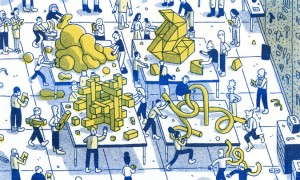 Stanford 2025, a yearlong project aimed at developing “provocations” to stimulate discussion, was unveiled in May 2014 during two interactive sessions that invited participants to imagine what higher education might look like a decade ahead. Four “radical” ideas are the provocations that emerged from the sessions: 1. Open Loop University – extend college to six years rather than the current four years, 2. Paced Education – coursework paced to individual readiness, 3. Axis Flip – instead of accumulating knowledge by discipline, students would focus on acquiring transferable skills and so-called competencies, and 4. Purpose Learning – declare a mission rather than a major. Items 3 and 4 are of particular interest to me given my development of the theory of the wide toolbox, and identification of a cohort at Yale that is engaged in self-directed learning to close the gap between what they desire to learn and what is actually taught in the classroom.
Stanford 2025, a yearlong project aimed at developing “provocations” to stimulate discussion, was unveiled in May 2014 during two interactive sessions that invited participants to imagine what higher education might look like a decade ahead. Four “radical” ideas are the provocations that emerged from the sessions: 1. Open Loop University – extend college to six years rather than the current four years, 2. Paced Education – coursework paced to individual readiness, 3. Axis Flip – instead of accumulating knowledge by discipline, students would focus on acquiring transferable skills and so-called competencies, and 4. Purpose Learning – declare a mission rather than a major. Items 3 and 4 are of particular interest to me given my development of the theory of the wide toolbox, and identification of a cohort at Yale that is engaged in self-directed learning to close the gap between what they desire to learn and what is actually taught in the classroom.
The rigid teacher-classroom model needs to be reformed in order to prepare students to become “daring, creative, and resilient problem solvers,” asserted Sarah Stein Greenberg of the Stanford University d. School. Ms. Stein Greenberg was one of the principal organizers of the Stanford 2025 project. It is interesting that Stanford, like MIT, is challenging the conventional approach to college education. Both institutions are attempting to reinvent the “why” of higher education. The notion is to connect the meaning or “the why” behind one’s studies and actions. I believe that this is what the wide toolbox cohort at Yale is doing. While they are constrained by the system that requires students to declare a major and meet the major’s requisite requirements to graduate; this cohort is also doing what the Stanford project declares students should do: declare a mission, not a major. In other words, students couple their area of learning with the purpose that fuels it.
Devika, a recent Yale College graduate, majored in architecture because the subject met her criteria of combining her interest in rigorous problem solving and humanities. During our conversation she informed me that she started college as a physics major but switched to architecture. I asked whether there was any relationship between physics and architecture. She responded accordingly:
Physics and architecture are essentially the same things in my mind. They are both essentially forms of problem solving. In physics, a lot of the circumstances are idealized. You have your white box. You are essentially using math, the equations that govern the universe to figure out how certain things work. Physics in general is quite beautiful. Architecture involves a lot of the same problem solving. Except you have a little more freedom. You are essentially designing the problem and the solution concurrently in architecture. You get to set the parameters as you go. You have to be a polymath to be an architect.
Being mission driven rather than major driven will put students in a position where they will take a more interdisciplinary approach to how they select their courses and extracurricular activities. This phenomenon is what Stanford 2025 refers to as “purpose learning.” Students, in other words, pursue meaning and impact through their studies and projects.
“The long term societal impact is human capital development,” notes Stanford 2025. Moreover, this human capital, along with entrepreneurship, might be the most important element for today’s students to create their own jobs, control their own labor, control the means of production and their intellectual property. The wide toolbox cohort pursues meaning and impact through their studies and activities because their mission is to engage in curiosity-driven learning inside and outside the conventional classroom. While the d. School project is intended to be implemented over the next decade or so, I feel that the wide toolbox cohort is creatively taking advantage of the intellectual and physical resources at Yale to facilitate self-directed learning today.